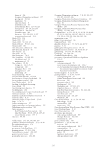19 – Mining and the Lake Eyre Basin environment 177 production of copper with nearly three-quarters of the nation’s remaining copper resources, dominated by the Olympic Dam mine (78.7 Mt copper , Cu). The Mount Isa Block also has most of Australia’s lead–zinc (Pb–Zn) resources (Table 19.1), dominated by the Mount Isa mining complex (20.3 Mt Pb, 32.5 Mt Zn). Most of Australia’s uranium resources (uranium oxide, U 3 O 8 ) are in central South Australia, dominated by Olympic Dam mine (2.5 Mt U 3 O 8 ), with some uranium from the Mount Isa Block (albeit mostly refractory ores which effectively remain uneconomic). Relatively minor deposits of gold are also mined with other metals, contributing considerably to the economic viability of projects (e.g. Prominent Hill, Olympic Dam, Ernest Henry, Osborne Table 19.1). Minor metals (silver, cobalt, molybdenum and the rare earth oxides), often found in copper deposits in or near the Lake Eyre Basin, also contribute to production. There are also rare earth projects around the margins of the Lake Eyre Basin, particularly Olympic Dam (~52.5 Mt). Using 2013 prices for metals – copper $7572/t, uranium ~$95 000/t U 3 O 8 , gold $46 755/kg, silver $785.6/kg, rare earths (assuming a light-dominant rare earth mix) ~$30/kg (adapted from OCE 2014 United States Geological Survey 2015) – makes the rare earths at the Olympic Dam site worth about $1274 billion, more than the combined worth of copper, uranium, gold and silver ($1004 billion). ‘Frontier’ areas for mineral and energy exploration (e.g. the Pedirka, Arckaringa and southern Galilee basins) are portrayed as regions for significant hope of discovery and potential development, especially unconventional gas (either CSG, tight gas or underground coal gasification), and although there are some reported coal resources (e.g. Alpha, Carmichael), there are no formal estimates of gas reserves (as of 2013). There is also potential in these basins for underground coal gasification or coal-to-liquids projects, although these methods remain arguably uneconomic and are deeply controversial for their environmental impacts (e.g. Linc Energy near Chinchilla in Queensland). Other relatively minor commodities (e.g. mineral sands or potash) may also prove economically viable, if exploration is successful, though the balance between economic value and environmental and social risks and benefits remains largely untested. Megatrends and their environmental implications I now review the history and future for mining developments in the Lake Eyre Basin and immediate surrounds by examining the current understanding of base metal, petroleum and gas and rare earth mining. Base metals Australia’s production of base metals (copper, lead and zinc) is increasing gradually, dominated by big projects around the margins of the Lake Eyre Basin (e.g. Mount Isa, Cannington, Olympic Dam and Century mines). Megatrends affecting modern mining include declining ore grades increasing tailings’ volumes increasing use of megapits increasing project scales increasing waste rock movements more environmental scrutiny during assessment and approvals more stringent regulatory oversight (at least in theory) more complex ores (especially mineralogy) requiring increased grinding and use of processing technology and more demanding expectations from local communities and interested
Downloaded from CSIRO with access from at 216.73.216.187 on Nov 17, 2025, 12:08 AM. (c) CSIRO Publishing

















































































































































































































































































